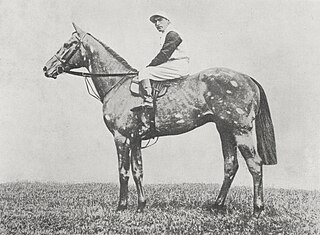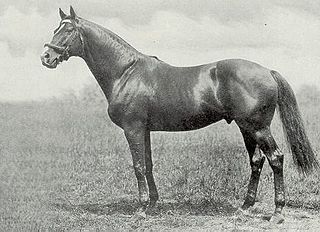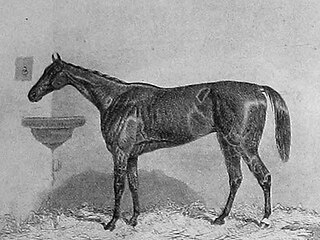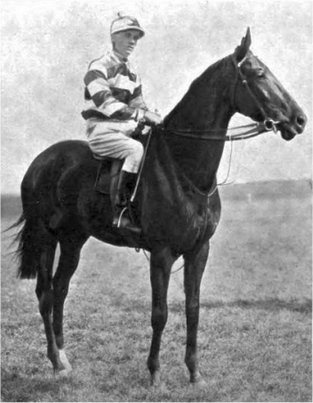
Glencoe (1831–1857) was a British bred Thoroughbred racehorse, who won the 2,000 Guineas Stakes and the Ascot Gold Cup. He was one of the earliest Thoroughbred stallions imported into the United States and was a top broodmare sire there. Several outstanding sons of Lexington were out of Glencoe mares, including Asteroid, Kentucky and Norfolk.
La Troienne (1926–1954) was one of the most famous and influential Thoroughbred broodmares in twentieth century America. She produced 10 winners including two Hall of Fame inductees while at stud, while her daughters in turn produced many notable offspring. In 2000, pedigree expert Janeen Oliver designated her as the taproot of family 1-x, a designation that was implemented by the Pedigree Online Thoroughbred Database in 2003. Recent matrilineal descendants include 2003 Horse of the Year Mineshaft, Japanese Triple Crown winner Contrail (2020), Kentucky Derby winners Smarty Jones (2004) and Super Saver (2010), Belmont Stakes winner Essential Quality (2021), and Sussex Stakes winner Alcohol Free (2021).

The Tetrarch (1911–1935) was an Irish-bred, British-trained Thoroughbred racehorse. He was undefeated in a racing career of seven starts and was voted the best British-trained two-year-old of the 20th century according to the National Horseracing Museum. He did not race after 1913 and was retired to stud where he became an influential sire.

Hurry On was an undefeated British Thoroughbred racehorse and sire that revived the Matchem sire line. English trainer Fred Darling called Hurry On the best horse he ever trained.
Attraction is a retired British Thoroughbred racehorse who was bred in Scotland and trained in England. She won several important races and was the first horse to win both the 1000 Guineas and the Irish 1,000 Guineas. In a career which lasted from 2003 to 2005, she ran fifteen times and won ten races. She was also well known for her unusual and distinctive action.

Eleanor was a British Thoroughbred racehorse bred by Charles Bunbury and was the first female horse to win The Derby. Eleanor also won the 1801 Epsom Oaks among many other races before retiring from racing at age eight to become a broodmare for Bunbury. She produced the stallion Muley, which in turn sired the mare Marpessa and the influential stallion Leviathan which was exported to the United States in the early nineteenth century. Through the produce of her daughter Active, Eleanor is present in the pedigrees of 19th-century American Standardbred racehorses.

Virago (1851–1869) was a British Thoroughbred racehorse and broodmare. In a career which lasted from November 1853 to July 1855 she ran sixteen times and won eleven races. All but one of her victories came as a three-year-old in 1854, a year in which she dominated British racing, winning major events at distances ranging from one mile to three miles. Her wins included the classic 1000 Guineas at Newmarket, the Nassau Stakes and the Yorkshire Oaks against her own age and sex. More notable were her successes in open competition, including the Goodwood and Doncaster Cups and three of the season's most valuable handicap races. She was regarded by many British experts as one of the greatest racehorses of the 19th century.
Sun Stream was a British Thoroughbred racehorse and broodmare, best known for winning two Classics in 1945. The filly won five times from seven races in a track career which lasted from spring 1944 until June 1945. As a two-year-old in 1944 she won three races including the Queen Mary Stakes. After being beaten on her three-year-old debut she won the 1000 Guineas over one mile at Newmarket and a substitute Oaks over one and a half miles at the same course a month later. After her second classic win she was retired to stud, where her record as a broodmare was disappointing.

Jest (1910–1921) was a British Thoroughbred racehorse and broodmare, best known for winning two Classics in 1913. The filly won four times from eight races in a track career which lasted from July 1912 until July 1913. As a two-year-old in 1912 she won twice from four starts. On her three-year-old debut she won the 1000 Guineas over one mile at Newmarket and then won the Oaks over one and a half miles at Epsom a month later. She was retired from racing after being beaten in the Coronation Stakes at Royal Ascot and the Nassau Stakes at Goodwood. As a broodmare she produced the 1921 Epsom Derby winner Humorist before dying at the age of eleven.

Tiffin was a British Thoroughbred racehorse and broodmare, who was undefeated in a career of eight races. Tiffin won five races in 1928 including the National Breeders' Produce Stakes at Sandown Park and the Cheveley Park Stakes at Newmarket and was the highest-rated British two-year-old of either sex. Her three-year-old season was disrupted by illness and injury, but she won all three of her starts, proving herself the year's best sprinter with wins in the July Cup at Newmarket and the King George Stakes at Goodwood. At her peak she was regarded as one of the fastest racehorses in the world. At the end of her racing career she was retired to stud where she produced one foal before dying in 1931.

Cherry Lass (1902–1914), was a British Thoroughbred racehorse and broodmare who won two British Classic Races in 1905. In a racing career which lasted from summer 1904 until October 1905 she ran fifteen times and won nine races. As a three-year-old she won the 1000 Guineas over one mile at Newmarket and The Oaks over one and a half miles at Epsom Downs Racecourse a month later. She went on to win the St. James's Palace Stakes at Royal Ascot and the Nassau Stakes at Goodwood before finishing third when favourite for the St Leger Stakes. She was then retired to stud where she showed some promise as a broodmare before her death in 1914.

Jannette (1875–1905), was a British Thoroughbred racehorse and broodmare who won two British Classic Races in 1878. She was one of the leading British two-year-olds of 1877 when she was unbeaten in seven races including the Richmond Stakes at Goodwood. On her first appearance as a three-year-old she was beaten by Pilgrimage in the 1000 Guineas at Newmarket but reversed the form with that filly to win the Oaks at Epsom a month later. Later in the season she defeated some of the season's best colts to win the St. Leger Stakes at Doncaster and added a victory in the Champion Stakes against some of the leading older horses. She was less effective in 1879 but won the Jockey Club Cup on her final appearance. She was then retired to stud, where she had some success.
Rowena was a British Thoroughbred racehorse and broodmare that won the classic 1000 Guineas at Newmarket in 1820. On her only other appearance, she finished second in the Oaks Stakes. She later became a successful broodmare.

Cobweb (1821–1848) was an undefeated British Thoroughbred racehorse and who won two British Classic Races as a three-year-old and went on to become a highly successful broodmare. Cobweb's racing career consisted of three competitive races in the early part of 1824. After winning on her debut she claimed a second prize when her opponents were withdrawn by their owners. She then won the 1000 Guineas at Newmarket Racecourse and the Oaks Stakes at Epsom Downs Racecourse before being retired to stud.

Pindarrie was a British Thoroughbred racehorse. He raced five times and won the Riddlesworth Stakes and 2000 Guineas Stakes. He was owned by George FitzRoy, 4th Duke of Grafton, and trained by Robert Robson. He only raced in 1820 and was then sent to India.

Love in Idleness was a British Thoroughbred racehorse and broodmare. Her diminutive stature and courageous racing style made her one of the most popular horses of her time. She showed very promising form as a two-year-old in 1920 when she won four time from five starts. In the following year she was arguably the best three-year-old filly in England as she won the Epsom Oaks, Sandringham Stakes, Yorkshire Oaks and Park Hill Stakes. After retiring from racing he had some success as a dam of winners.

Our Lassie was a British Thoroughbred racehorse and broodmare. She was a very good performer as a juvenile in 1902 when she won the Sandown Produce Stakes and was placed in her other three starts. In the following year she failed in the Lincoln Handicap but the recorded a decisive win in the Oaks Stakes. She failed to win or place in four subsequent races and was retired from racing at the end of 1904. As a broodmare she produced a few winners but had her biggest impact on the future of Thoroughbred racing through her unraced daughter Lady Brilliant.
Electra was a British Thoroughbred racehorse and broodmare. A a two-year-old she showed considerable promise as she won four time from eight starts and finished second on three occasions. In the following year she won the 1000 Guineas and the Park Hill Stakes as well as finishing second in the Newmarket Stakes, Coronation Stakes and Free Handicap. She appeared to be most unlucky when running unplaced in the Epsom Oaks. She failed to win as a four-year-old and was retired from racing but later became a very successful broodmare.

Flair was a British Thoroughbred racehorse and broodmare. After finishing fourth on her debut in July 1905 she was undefeated in her four subsequent races. She was the dominant two-year-old of either sex in England in the autumn of 1905, beating male opposition to take the Imperial Produce Stakes, Middle Park Plate and Free Handicap. In the following spring, she was a very easy winner of the 1000 Guineas and was strongly fancied for the Epsom Derby before her racing career was ended by injury. Her record as a broodmare was disappointing.

Aida was a British Thoroughbred racehorse and broodmare. As a juvenile she finished second on her debut and then defeated the future Epsom Derby winner Volodyovski in the Imperial Produce Stakes. She won the 1000 Guineas on her first appearance of 1901 and then finished a close third in a very strong edition of the Newmarket Stakes. She finished unplaced in the Eclipse Stakes and the St Leger and was retired from racing at the end of the year. As a broodmare she had an enduring influence on the breed through her daughter Herself.















